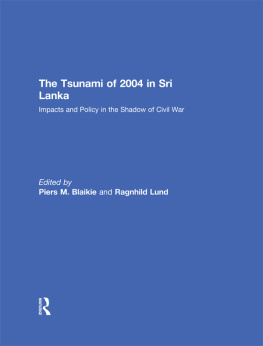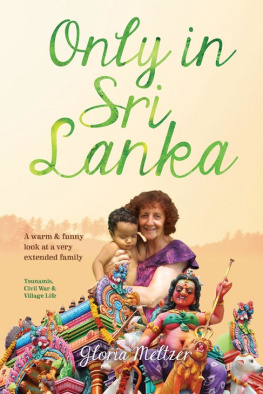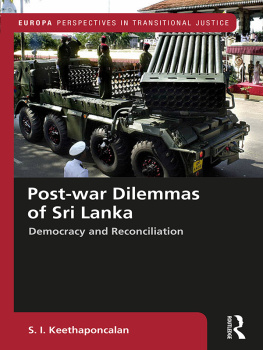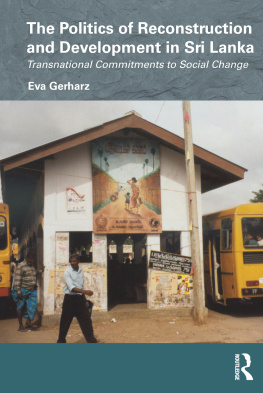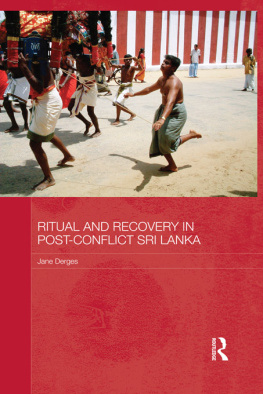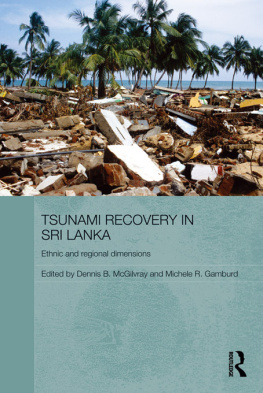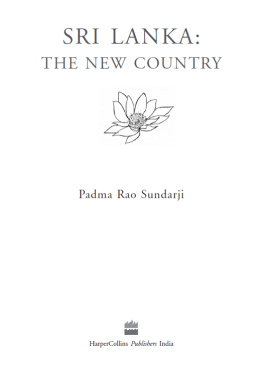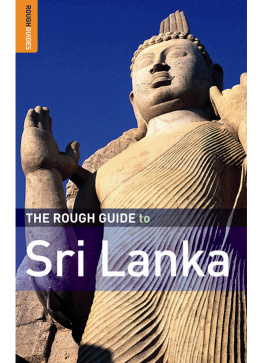The Tsunami of 2004 in Sri Lanka
This book is based on empirical research in Sri Lanka conducted after the catastrophic tsunami which hit the country in December 2004. The aims of the research have been to develop new knowledge on post-crisis reconstruction and recovery work, on how to bridge the knowledge gap between researchers and practitioners, as well as trying to use past research experiences from Sri Lanka to learn about the present day situation. The chapters use a common analytical frame related to the policy narratives of post-tsunami recovery in the shadow of war, and deal with housing reconstruction, livelihoods, internally displaced, humanitarian interventions and protracted conflicts.
The authors represent various social scientific fields and they have experience from different geographical areas of Sri Lanka.
This book was published as a special issue of Norsk Geografisk Tidsskrift.
Piers M. Blaikie is Emeritus Professor in the School of International Development at the University of East Anglia, Norwich, United Kingdom.
Ragnhild Lund is a Professor in the Department of Geography at the Norwegian University of Technology, Trondheim, Norway.
The Tsunami of 2004 in Sri Lanka
Impacts and Policy in the Shadow of Civil War
Edited by Piers M. Blaikie and Ragnhild Lund
First published 2010 by Routledge
2 Park Square, Milton Park, Abingdon, Oxon, OX14 4RN
Simultaneously published in the USA and Canada
by Routledge
270 Madison Avenue, New York, NY 10016
Routledge is an imprint of the Taylor & Francis Group, an informa business
2010 Taylor & Francis
Typeset in Times by Value Chain, India
Printed and bound in Great Britain by TJ: Digital Ltd, Padstow, Cornwall
All rights reserved. No part of this book may be reprinted or reproduced or utilised in any form or by any electronic, mechanical, or other means, now known or hereafter invented, including photocopying and recording, or in any information storage or retrieval system, without permission in writing from the publishers.
British Library Cataloguing in Publication Data
A catalogue record for this book is available from the British Library
ISBN10: 0-415-55909-X
ISBN13: 978-0-415-55909-6
CONTENTS
Ragnhild Lund
Piers M. Blaikie
Cathrin Brun and Ragnhild Lund
John Nigel
Hazel Lang and Anita Knudsen
Suzanne Y. A. Tete
Kalinga Tudor Silva
Sarah Khasalamwa
Jennifer Hyndman
Editorial
The tsunami of 2004 in Sri Lanka: Impacts and policy in the shadow of civil war
During the past decade the NTNU Research Group on Forced Migration, which is located at the Department of Geography, Norwegian University of Science and Technology (NTNU), has worked with several research projects in Sri Lanka. Much of the work has been carried out after the catastrophic tsunami hit the country in December 2004. The group has worked with NGOs on various aspects of capacity building, with local research partners from the University of Peradeniya, the South Eastern University of Sri Lanka, and the Eastern University, Sri Lanka, and also researchers from various disciplines at NTNU. The research aims have been to develop new knowledge on what constitutes post-crisis reconstruction and recovery work, on how to bridge the knowledge gap between researchers and practitioners, as well as trying to use past research experiences from Sri Lanka to learn about the present day situation. This book is one outcome of these activities, and represents an effort to synergise and build upon the knowledge and perspectives of researchers directly linked to the research activities of the forced migration group and associated partners. Encouraged by Piers Blaikie's idea to work on various policy narratives of post-tsunami recovery in the shadow of war (see chapter one), the authors have been inspired to analyse policy processes and policy narratives related to their field of expertise and the various facets of reconstruction and recovery work after the tsunami.
Within the broad brief of the Research group on Forced Migration, the two intertwined disasters of tsunami and civil war in Sri Lanka form the focus of this book. As Chapter One will explain in more detail, it may seem that a tsunami (an event taking place over a few minutes) and a protracted civil war over more than twenty years could not be more different in terms of impact and policy. However, they are linked in a number of inseparable ways. Firstly, in both cases there is a long history of the reproduction of inequality and vulnerability, which renders certain people (differentiated by age, sex, kinship, ethnic identity, livelihood, wealth, political networks) more vulnerable to disaster than others. Of course it is obvious that a civil war and a tsunami will have quite different impacts but the underlying patterns of vulnerability on which these two different disasters develop have similar histories of ethnic tension, discrimination and dispossession. Secondly, the impacts of the war and the tsunami are inextricably linked. Patterns of mortality, loss of home and livelihood and displacement following the tsunami are not formed on a tabula rasa but overlay those caused by the war. Therefore, in many cases and locations (particularly in the north and east of Sri Lanka and in coastal regions) many but not all the impacts of the war and the tsunami have to be understood in the context of each other. Thirdly, many of the policies which relate to the effects of the war and the tsunami also have common origins. After all the Government of Sri Lanka is the final arbiter of policies which address both issues and many of the international, bi-lateral and local actors which have some influence on policy are the same.
However, while we were working on this project, the relative importance of these two disasters altered. The war in Sri Lanka intensified, and we experienced a situation in which the issue of the tsunami was almost forgotten in a maze of new policies which were shaped during the final stage of the brutal war in the LTTE (Tamil Tigers Liberation Movement) controlled areas. Sri Lanka's government on May 18 declared victory over the LTTE and later the said founder Vellupalai Prabhakaran was killed. That effectively ended the LTTE's struggle to create a separate state for minority Tamils, which began in the 1970s and erupted into civil war in 1983. What the war has meant for the post-tsunami recovery work going on in the country still remains to be seen.
As of the date of writing this Introduction (July 2009), debates on the new challenges related to the post-war reconstruction dominate the media. The post-tsunami recovery work has come to a halt and the voices of those who have still not been compensated for their losses during and after the tsunami have been muted. This is also a tragedy, as a substantial number of people who have been displaced after the tsunami have not yet been given compensation and houses, their livelihoods have not been restored, and individuals and whole communities are still traumatised. Bearing this in mind, what constitute the major challenges in post-war Sri Lanka?
One major challenge is to handle the humanitarian crisis which prevails in the north of the country. Throughout the war, and particularly during its final stage, civilians displaced by the conflict were facing a severe crisis. Hundreds of thousands of people were displaced from the north within a so-called No-fire Zone with extremely limited humanitarian relief. The Sri Lankan government posed severe restrictions on international humanitarian organisations in the conflict zone in September 2008, so very limited humanitarian space limited their access to the displaced (iDMC 2009). At the end of the war the human costs were huge. According to recent, albeit uncertain estimates, nearly 24,000 soldiers were killed and 5,000 left permanently disabled (AlertNet1 2009); between 80,000100,000 people were believed killed during the war, and exceeding 20,000 during the final month of the government's siege against the LTTE (AlerntNet2 2009); and about 290,000 Tamil civilians remain inside camps (AlertNet3 2009).

